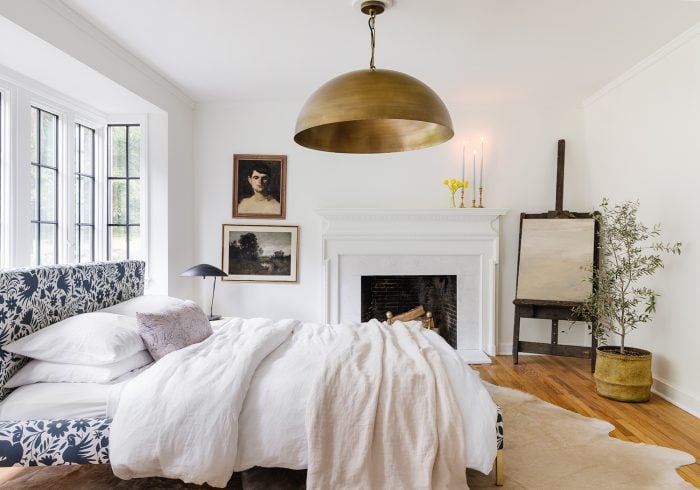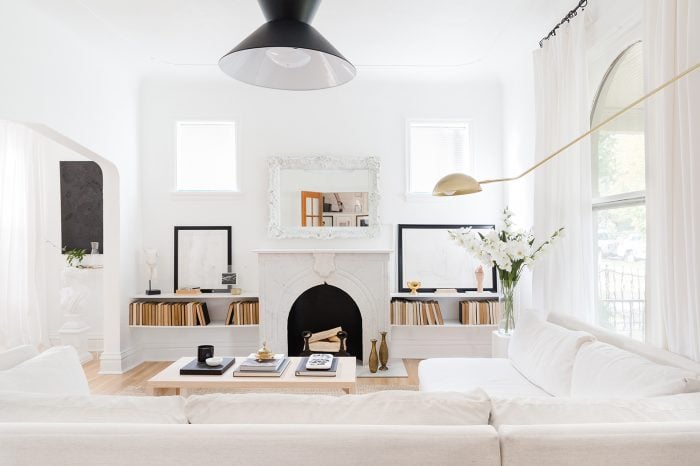We’re all for a highly curated, well-designed space, but it is entirely possible for a home to look too perfect. Yes, there is absolutely a time and place for a symmetrical layout, particularly for a more traditional vibe. Who doesn’t love a set of matching nightstands?
But to be frank, symmetry can be the low hanging fruit of interior design. Mirroring a scene (i.e. matching chairs on either side of a sofa) is an easy go-to, but sometimes, too much symmetry —mirroring everything — can be off-putting and even feel a bit impersonal. In fact, we’d argue that asymmetrical (yet balanced) rooms are among the most interesting, unique, and high-end spaces.
That’s why we implore you to consider asymmetry as a guiding principle when designing your home. Learning to craft a balanced-yet-asymmetrical space is truly an art form — but it’s a worthwhile challenge. Asymmetrical designs offer a warm, lived-in aesthetic full of unique, eye-catching moments that help you experience the place in its entirety. If you’re up to the task, we have a few designer-approved tips that will help you master asymmetrical balance in interior design in your own space, on your own terms.
1. Reject the Obvious

With an asymmetrical approach, you need to reject the literal, mirror-image equilibrium and seek out balance in more abstract terms. If you have matching sconces on either side of a centered fireplace, for example, skip the matching accent chairs and flank the look with mis-matched seating for a bit of asymmetry and visual intrigue. The look is still balanced, but in an unexpected way.
The same principle holds true for smaller vignettes. Consider an entryway scene, for example. Create a sense of flow with a larger sculptural lamp on one side of a centered console, and balance the weight on the floor with a woven basket on the opposite side. This creates a unique little zig-zag moment, rather than resorting to the obvious: matching table lamps.
2. Counterbalance With Furniture

Asymmetry is often best achieved when every detail is thoughtfully considered. Picture a room with a crucial walkway on the left, like the above living space. Naturally, the furniture will end up on the right side of the room so as not to block the walkway, creating an imbalanced feel. To add more visual weight on the left side without mirroring the right, bring in a bold or eye-catching piece of furniture, like a matte black bookcase, with surrounding decor. The furniture is far from matching, but the overall look feels balanced.
3. Switch Up Shapes & Silhouettes

Creating intentional asymmetry can be as simple as varying furniture shape and silhouette. Rather than opting for a low-slung sofa paired with matching upholstered accent chairs, for example, bring in mis-matched chairs with contrasting silhouettes. In the above living room, the layout itself is balanced (a centered sofa with accent chairs on either side), but the chairs themselves add contrast and asymmetry. One is angular, open-frame, and boasts mixed materials, while the other is upholstered and curved with no visible frame. Similarly, the sofa and reclining chair are both rectangular and sharp, while the rust-colored chair and coffee table are curved and soft. Balance is still achieved, but the contrasting shapes, silhouettes, and heights keep things interesting.
4. Play With Height

If you’re hoping to create some asymmetry within a balanced layout, use height to your advantage. For example, cluster tall candlesticks on one side of a centered fireplace and leave the other side blank to create visual tension and intrigue. Hang stacked artwork on the empty side to create balance in less obvious way. Playing with height in your chosen decor, furniture, and lighting creates welcome tension without throwing a space off-balance.
5. Create Continuity Elsewhere

To avoid visual chaos and make asymmetry truly sing, always create continuity elsewhere. A cohesive color palette and tight selection of materials will make mis-matched furniture and an off-kilter layout feel curated instead of random. In the above space, for example, the repeated use of black, white, and tan balances out the mis-matched light finishes, right-aligned seating, and perpendicular wall art.
6. Lean Into Odd Numbers

File this tip under “low lift, high impact.” To add a hint of asymmetry without going overboard, lean into odd numbers. For example, try five dining chairs around your kitchen table, three accent chairs in your living space, or seven pieces of artwork in a gallery wall. This simple tweak creates natural asymmetry and gives a space that certain laid back vibe.
Ready to design a space that’s purposefully off-kilter and beautifully on point? Our designers can help you get there, along with more pro tips. Take our style quiz and get started on your dream space.

